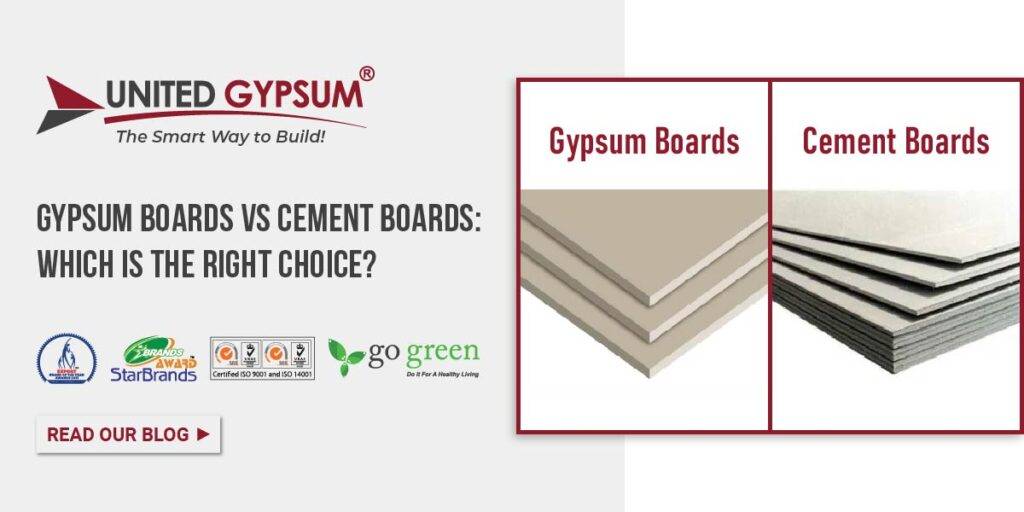Choosing the right construction supplies in the field of construction and interior design can exert a substantial impact on the overall value and longevity of a construction project. Gypsum boards and cement boards are the two most popular choices for both ceiling and wall applications. But which one is the preferable choice? For your next building endeavor, we will help you make an informed selection by going over the characteristics, advantages, and intended applications of both cement boards and gypsum boards in the following paragraphs.
Gypsum Boards
a) Characteristics and Composition:
- A compound called calcium sulphate dihydrate is used in the manufacture of gypsum boards.
- Their structure consists of two separate sheets of durable paper encasing a firm gypsum core.
- Gypsum boards offer versatility for use in construction since they are available in a range of dimensions and densities.
- Commonly, they are offered in standard, fire-resistant, moisture-resistant, and foil-backed variants.
b) Applications:
- Gypsum boards are frequently employed for interior ceilings, partitions, and walls.
- They perform adequately for both commercial and residential structures. Drywall installation has gained popularity as a swifter substitute for conventional lath and plaster building work.
- Gypsum boards have applications in a variety of settings, including residences, companies, retail stores, and educational institutions.
c) Advantages:
- Considering that the core of gypsum boards is non-combustible, they provide exceptional fire protection.
- They are reasonably priced and readily accessible in the market.
- Gypsum boards enable acoustic insulation, making them perfect for spaces that require noise abatement
- Installation is relatively quick and straightforward, facilitating time-efficient construction.
- Moisture-resistant variants (green paper covering) employ a combination of wax and silicone compounds in its outer layer to fortify surfaces against moisture and wet environments.
Cement Boards
a) Characteristics and Composition:
- Cement boards are produced out of Portland cement, sand, and either cellulose or fiberglass reinforcement.
- They are stronger and more durable in comparison to gypsum boards.
- Cement boards can be obtained in a variety of dimensions to accommodate a multitude of applications.
b) Applications:
- Wet spaces like bathrooms, cooking areas, and outer walls are frequent sites to employ cement boards.
- They offer outstanding protection against mold and dampness.
- Heavy-duty applications like cladding and tiling may additionally benefit from cement board utilization.
c) Advantages:
- Cement boards are enduring and do not swell or shrink in response to variations in humidity and temperature.
- They are perfect for locations that are frequently damp because of their exceptional water resistance.
- Tile installations might benefit from the firm surface of cement boards.
- They can tolerate high pressures and have good impact resistance.
A Comparison Between Cement Boards and Gypsum Boards
1. Durability and Moisture Resistance:
Standard gypsum boards are more susceptible to being damaged in damp situations and have a less robust resistance to moisture. In contrast, cement boards are far more resistant to moisture and have a lower potential for the growth of molds and mildew.
2. Strength and Impact Resistance:
When compared to gypsum boards, cement boards have superior strength and resistance to impacts. Gypsum boards are more vulnerable to breakdown and denting from strong blows.
3. Fire Resistance:
Both gypsum boards and cement boards offer favorable fire resistance. Nonetheless, the incombustible core of gypsum boards gives them a competitive edge. Naturally fire-resistant, gypsum can withstand flames for up to four hours when formed into gypsum panels.
4. Ease of Handling and Installation:
Gypsum board is lightweight, which lowers transportation expenses as well as makes it easier to handle and install. On the flip side, cement boards are bulky and can be challenging to move and set up, particularly in larger spaces. Gypsum board is effortlessly cut with an all-purpose knife. However, when cutting cement board, you’ll require a circular saw that comes with a heavy-duty blade. To install a gypsum board, consider drywall screws with tapering heads. For mounting cement boards, however, you’ll need roofing nail heads or galvanized decking screws.
5. Versatility:
Gypsum board is also extremely versatile since it can be cut into various sizes and forms, making it suitable for a broad range of applications. To create a personalized look, gypsum board can also be painted, textured, or given other treatments. In comparison, the design freedom of cement boards is considerably constrained. Unlike gypsum boards, they are more difficult to mold, paint, or polish. Consequently, employing gypsum boards for DIY projects is an increasingly prevalent choice. In real-world applications, cement boards typically get installed by experts in the field.
Selecting the Right Board for Various Applications
- For interior surfaces such as ceilings and walls in areas without moisture, gypsum boards are an appropriate and cost-effective choice.
- Wet areas, such as bathrooms and kitchens, can benefit from cement boards as well as moisture-resistant Smart gypsum boards to guarantee durability and resistance to moisture.
- For heavy-duty applications, such as tiling or cladding, cement boards are the preferred option due to their strength and rigidity.
- In locations where weight limits are an issue, the reduced load on the frame or structure due to the lightweight nature of gypsum board could prove significant.
Final Remarks
When choosing between gypsum boards and cement boards, taking into account the specific requirements, environmental conditions, and intended use of the material becomes crucial. Cement boards are superior in strength, durability, and resistance to moisture than gypsum boards, which are more feasible, cost-effective, and easy to install. In the long run, you may select the most suitable board for your building or renovation requirements by evaluating the project’s demands and consulting with construction professionals.

